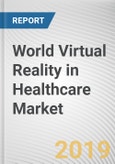The global virtual reality in the healthcare market is segmented on the basis of technology, application and geography. On the basis of technology, the market is segmented into, Full Immersive VR, Semi-Immersive VR and Non- Immersive VR. The market, on the basis of application segmented into Surgery simulation, Phobia treatment, Robotic surgery, Education and Training, Visualization and Rehabilitation, Treatment of Post-Traumatic Stress Disorder (PTSD), Treatment of Autism, Diagnosis of cognitive disorders and others. Geographically, the market is segmented across four regions namely North America, Europe, Asia Pacific, and LAMEA.
Some of the strategies adopted by top industry players include new product launches. For instance, in April 2015, Samsung collaborated with Nuance, a software developer, to integrate a new virtual assistant clinical documentation technology to the Samsung Gear S smartwatch with a view to assist medical professionals. CAE Healthcare, recently launched obstetrics and a gynecology simulation ultrasound training system in India. In 2014, Surgical Theater, received the FDA approval for SNAP device, a virtual reality device for surgical procedures.The companies profiled in this report include; Virtalis Ltd, CAE Healthcare, GE Healthcare, Virtual Realities Ltd, Qualcomm Technologies, Inc., Samsung, Vuzix Corporation, Mimic Technologies Inc, WorldViz, LLC., and Brainlab AG.
KEY MARKET BENEFITS
Comprehensive analysis of factors that drive and restrict the growth of the global virtual reality in healthcare market are provided
The report provides a quantitative analysis of the current market along with estimations through 2014-2020 that helps identify the prevailing market opportunities
An in-depth analysis of key segments of the market demonstrates the types of technologies and applications that are currently being used along with the variants that would gain prominence in future
SWOT analysis enables to study the internal environment of the leading companies for strategy formulation
Region-wise virtual reality healthcare market conditions are comprehensively analysed in the report
VIRTUAL REALITY (VR) IN HEALTHCARE MARKET SEGMENTS:
The global virtual reality in healthcare market is segmented below:
Global Virtual Reality in Healthcare Market - By Technology
Full Immersive VR
Semi-Immersive VR
Non- Immersive VR
Global Virtual Reality in Healthcare Market - By Application
Surgery simulation
Tele-surgery
Phobia treatment
Robotic surgery
Education And Training
Visualization And Rehabilitation
Treatment of Post-Traumatic Stress Disorder (PTSD)
Treatment of Autism
Diagnosis of cognitive disorders
Others
Global Virtual Reality
Methodology
The analyst offers exhaustive research and analysis based on a wide variety of factual inputs, which largely include interviews with industry participants, reliable statistics, and regional intelligence. The in-house industry experts play an instrumental role in designing analytic tools and models, tailored to the requirements of a particular industry segment. The primary research efforts include reaching out participants through mail, tele-conversations, referrals, professional networks, and face-to-face interactions.
They are also in professional corporate relations with various companies that allow them greater flexibility for reaching out to industry participants and commentators for interviews and discussions.
They also refer to a broad array of industry sources for their secondary research, which typically include; however, not limited to:
- Company SEC filings, annual reports, company websites, broker & financial reports, and investor presentations for competitive scenario and shape of the industry
- Scientific and technical writings for product information and related preemptions
- Regional government and statistical databases for macro analysis
- Authentic news articles and other related releases for market evaluation
- Internal and external proprietary databases, key market indicators, and relevant press releases for market estimates and forecast
Furthermore, the accuracy of the data will be analyzed and validated by conducting additional primaries with various industry experts and KOLs. They also provide robust post-sales support to clients.

LOADING...








